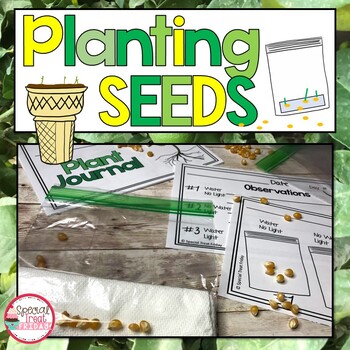Planting Seeds Activities | Plant Unit
- PDF
What educators are saying
Also included in
- This Plant Unit Bundle will be your complete guide planting seeds in your classroom, teaching your students all about the parts of plants, writing about plants and the function of plants. It includes everything that you need and all the hard work has been done for you. This unit was built using NPrice $17.50Original Price $34.35Save $16.85
Description
Planting seeds in the classroom is such a great Science Observation lab where students can study what plants need to grow and the the parts of the plant as it grows before their eyes. Even better is we use popcorn kernels! The students always think we are growing popcorn.
OBJECTIVE
Students will read about the parts of plants. Then they will make a plant journal to track their observations of their new plants. Students will plant 3 plants with different variables to see which one grows the best. Then they will transplant them once they sprout. The project will end with a parts of the plant art activity that can double as an assessment.
INCLUDED
- Close Reading Article about the Parts of Plants
- Close Reading Lesson
- Plant Journals Lesson & Activity (to be used during the duration of the growing plants)
- Planting Plants Lesson & activity
- Parts of the Plants Lesson and Interactive Activity
HOW IT IS SET UP
This mini unit is designed to be spread out to allow the plants time to grow which is around 5-8 days. The students will read the close reading article to give them the background knowledge, use the plant journals to keep track of their observations, plant their plants and watch which ones grow, then transplant the best. They will end the unit with an interactive art activity using the knowledge they have learned.
Check out our blog article to see how this will look in the classroom.
HOW IT WILL BENEFIT YOUR STUDENTS
Your students will grasp the idea of the parts of the plants and their features while also learning exactly what plants need to grow.
You might also be interested in our full 1st Grade Plant Unit or the 2nd Grade Version. I have planned out your entire plant unit for you. We also have many other plant related activities.
Don’t forget that leaving feedback earns you points toward FREE TPT purchases. I love FEEDBACK!
LET'S CONNECT Special Treat Friday Blog | Writing Membership | TPT | Facebook | Instagram | YouTube
As always, please contact me with any questions.
Thank you so much,
Special Treat Friday, Heather McKinsey






